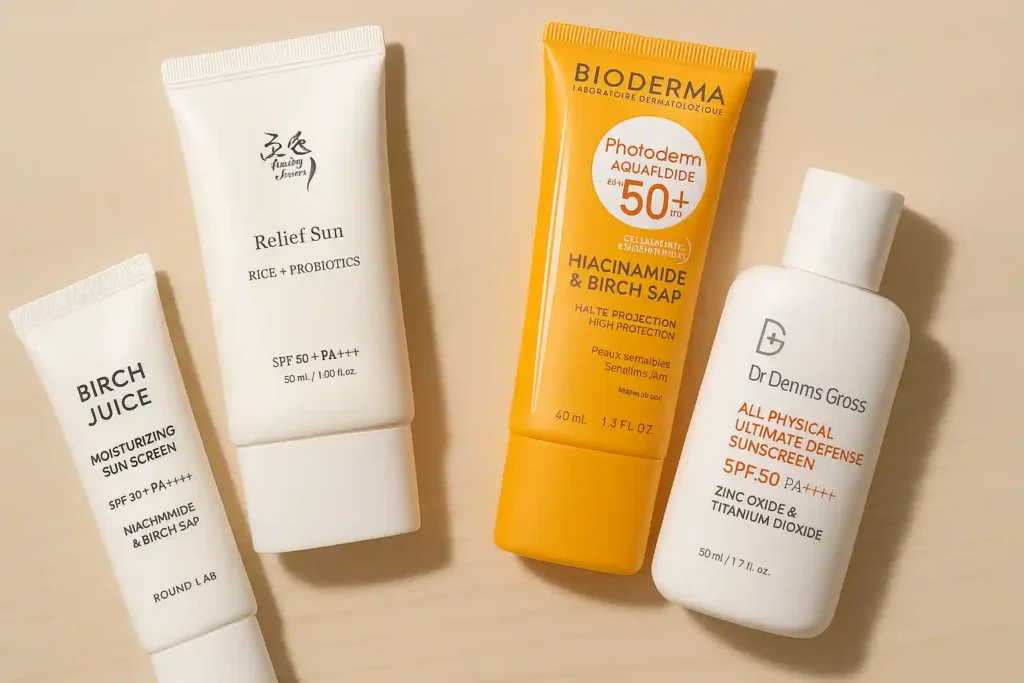
Discover the truth about bad ingredients in sunscreen and how to avoid them. Explore the beauty of Joseon sunscreen ingredients, known for their gentle, effective protection.
Learn about Bioderma sunscreen cream and Bioderma sunscreen lotion, trusted by dermatologists. Plus, find out why birch juice sunscreen is gaining popularity for its hydrating and protective benefits. Make safe sunscreen choices today!
Why Choosing the Right Sunscreen Could Save Your Skin
We all know sunscreen is a daily must-have. Whether it’s summer at the beach or just running errands in the city, protecting your skin from harmful UV rays isn’t optional, it’s essential.
Sunscreen doesn’t just prevent sunburn; it lowers the risk of premature aging, dark spots, and even skin cancer. Simply put, it’s one of the best skincare habits you can build.
But here’s the catch, not every sunscreen is as safe as it looks on the shelf. Some formulas contain bad ingredients in sunscreen that can raise health concerns, like irritation or hormone disruption, and even cause harm to coral reefs when washed off in the ocean.
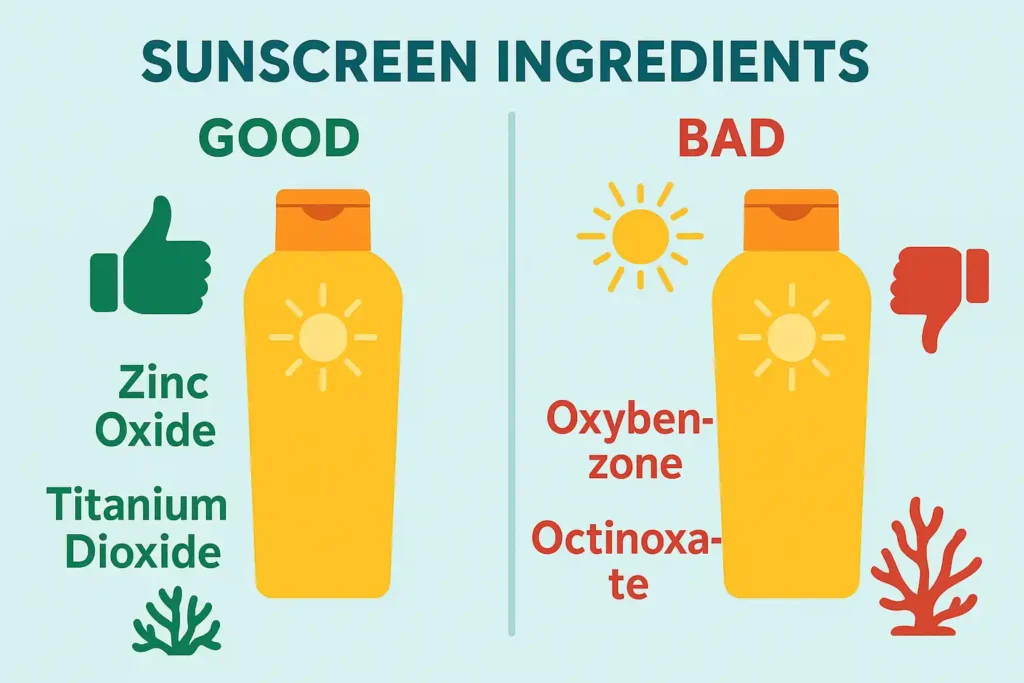
This is why learning how to read labels matters just as much as applying sunscreen daily.
In this guide, we’ll take a closer look at popular products people actually use.
We’ll explore beauty of joseon sunscreen ingredients, see what’s really inside bioderma sunscreen cream and bioderma sunscreen lotion, and even break down newer options like the birch juice sunscreen that’s trending online.
By the end, you’ll know which ingredients to avoid, which ones to trust, and how to choose a sunscreen that protects both your skin and the planet.
Why “Bad Ingredients in Sunscreen” Matter
When most people hear about bad ingredients in sunscreen, it can sound like just another internet scare. But the truth is, some of these chemicals come with very real concerns, both for your health and the environment.
On the health side, certain filters and preservatives may trigger skin irritation, hormone disruption, or even pregnancy-related risks.
For example, some people find their skin becomes extra sensitive or itchy after using sunscreens that rely heavily on unstable filters. That’s why understanding what’s inside your favorite product matters.
Whether you’re checking beauty of joseon sunscreen ingredients, reviewing bioderma sunscreen cream, or scanning the label of bioderma sunscreen lotion, the goal is to spot potential red flags before they touch your skin.
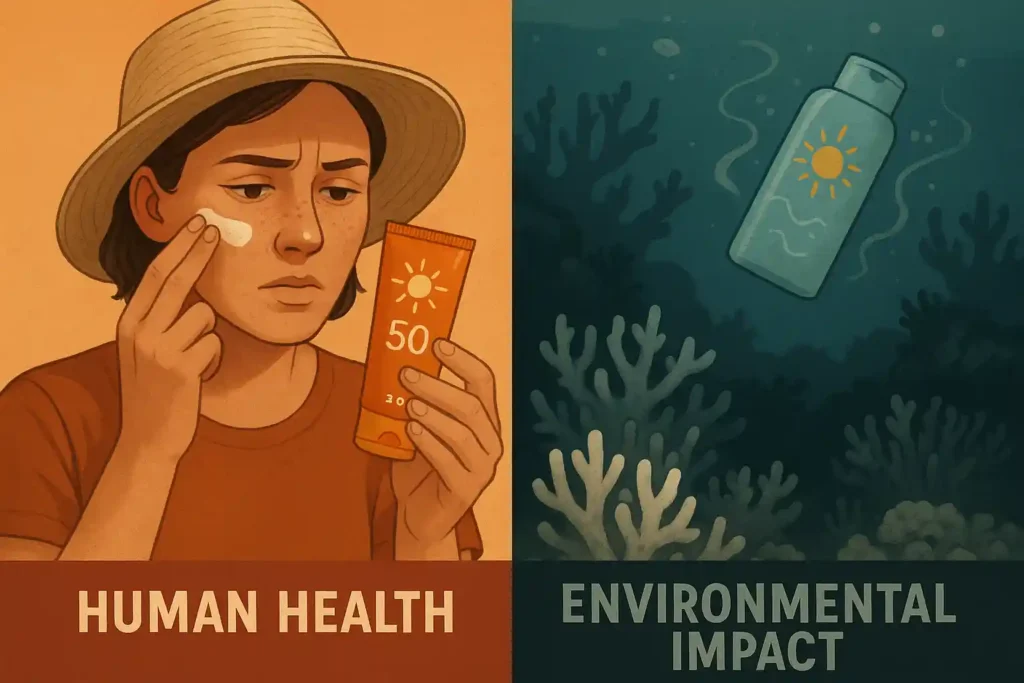
It doesn’t stop there. Environmental safety is another big reason to care. Studies have shown that when harmful sunscreen ingredients wash off in the ocean, they can damage coral reefs and marine life.
This concern has led places like Hawaii to ban certain chemicals completely. Even the much-hyped birch juice sunscreen trend needs a closer look at the ingredient list to make sure it’s reef-friendly.
So, this isn’t about fear, it’s about informed choices. Regulations are catching up, but at the end of the day, the power is in your hands every time you choose a sunscreen.
5 Common Bad Ingredients in Sunscreen: That Could Do More Harm Than Good
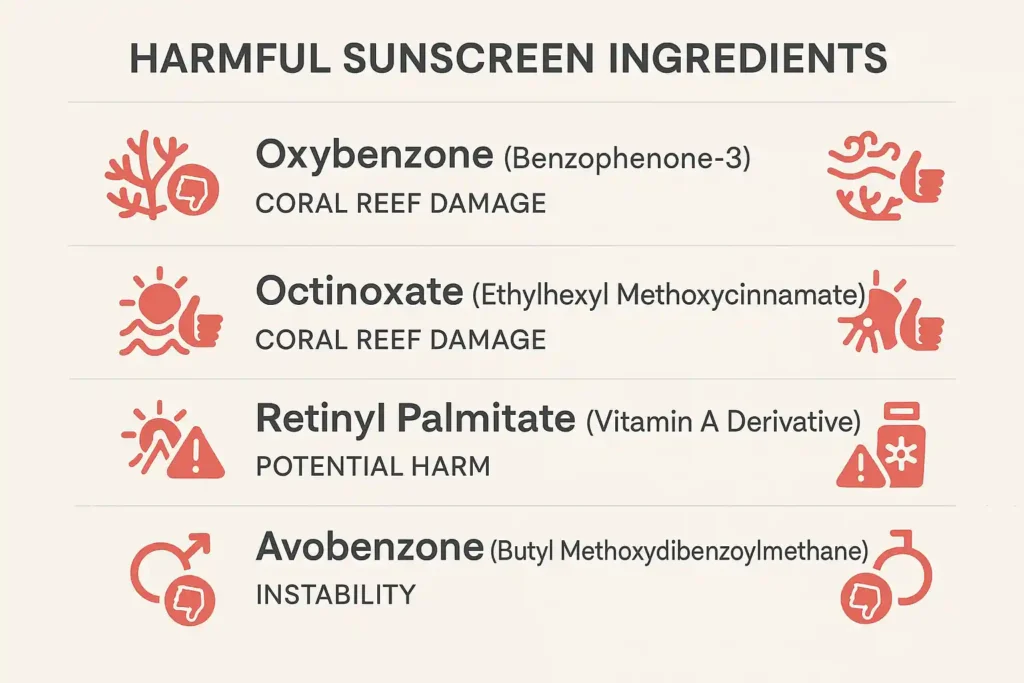
Reading sunscreen labels can feel like decoding a chemistry book. While many ingredients are safe and effective, there are some bad ingredients in sunscreen that experts and health authorities recommend avoiding.
These substances can cause irritation, disrupt hormones, or even damage the environment when they wash into the ocean.
Below, we’ll go through five of the most common culprits you’ll find on ingredient lists.
Keep this guide handy the next time you’re checking products, whether you’re looking at beauty of joseon sunscreen ingredients, browsing bioderma sunscreen cream, comparing bioderma sunscreen lotion, or even considering trendy options like a birch juice sunscreen.
1. Oxybenzone (Benzophenone-3)
Oxybenzone is one of the most talked-about chemical filters, and not in a good way. Research has linked it to hormone disruption, meaning it may mimic or interfere with the body’s natural hormones.
Some studies also suggest that oxybenzone can be absorbed through the skin, raising concerns for sensitive groups, including children and pregnant women.
Beyond personal health, oxybenzone is considered a reef-harming chemical. When swimmers wear sunscreens with this ingredient, it can wash off into the water and contribute to coral bleaching.
This is why Hawaii and several island nations have banned sunscreens containing oxybenzone altogether.
If you’re vacationing somewhere tropical, double-check your sunscreen to avoid fines and to protect marine life.
2. Octinoxate (Ethylhexyl Methoxycinnamate)
Octinoxate is another UV filter designed to protect against UVB rays, which cause sunburns. However, like oxybenzone, it has been flagged for its environmental impact. Studies show it can accumulate in waterways and harm coral reefs.
From a health perspective, octinoxate has been linked to allergic reactions in people with sensitive skin. If you’ve ever noticed redness or stinging after applying sunscreen, this could be the culprit.
Some countries and states have already started regulating sunscreens with octinoxate, especially in areas that rely on reef ecosystems.
3. Retinyl Palmitate (Vitamin A Derivative)
At first glance, retinyl palmitate sounds like a positive addition. After all, Vitamin A is well-known for its anti-aging benefits in creams and serums. But in sunscreens, it’s a different story.
When retinyl palmitate is exposed to sunlight, it may actually increase the risk of skin damage. Some studies suggest that it could accelerate the development of skin tumors and lesions in lab animals when combined with UV exposure.
While more research is needed, many dermatologists recommend avoiding sunscreens with this ingredient, especially during the daytime.
4. Avobenzone
Avobenzone is a widely used UVA filter, and on paper, it’s very effective. The problem? It’s unstable. On its own, avobenzone breaks down quickly when exposed to sunlight, losing up to 50% of its filtering ability within an hour.
To solve this, many companies combine avobenzone with stabilizers. When done properly, this makes it a safer and more reliable option.
Brands like bioderma sunscreen cream and bioderma sunscreen lotion often work hard to ensure photostability in their formulas. But not every product on the market invests in these extra measures.
Always check if the sunscreen mentions “photostable” on the label when avobenzone is included.
5. Parabens (Preservatives)
Parabens are preservatives added to extend the shelf life of skincare products, including sunscreens. While effective, they’ve been linked to hormone disruption and have been detected in human tissues.
This raises concerns about long-term exposure, especially with daily-use products like sunscreen.
Thankfully, many modern sunscreens are now marketed as “paraben-free.” For example, if you scan beauty of joseon sunscreen ingredients or look at newer clean-beauty formulas like birch juice sunscreen, you’ll often find safer preservative alternatives being used.
INCI Cheat Sheet: Screenshot-Friendly List
Here’s a quick reference you can save on your phone:
| Ingredients | INCI names |
| Oxybenzone | Benzophenone-3 |
| Octinoxate | Ethylhexyl Methoxycinnamate |
| Retinyl Palmitate | Vitamin A Palmitate |
| Avobenzone | Butyl Methoxydibenzoylmethane |
| Parabens | Methylparaben, Propylparaben, Butylparaben |
Next time you’re scanning labels at the store, use this list as your “red flag” guide.
Final Thoughts
Spotting bad ingredients in sunscreen isn’t about fear, it’s about empowerment. By knowing what to look for, you can choose sunscreens that keep your skin safe without exposing you to unnecessary risks.
And the good news? Many brands today, from bioderma sunscreen cream to beauty of joseon sunscreen ingredients, are moving toward safer and more environmentally responsible formulas.
When in doubt, remember: safe sunscreen is not only about SPF numbers, but also about what’s hiding inside the bottle.
Brand Spotlight: Beauty of Joseon Sunscreen Ingredients
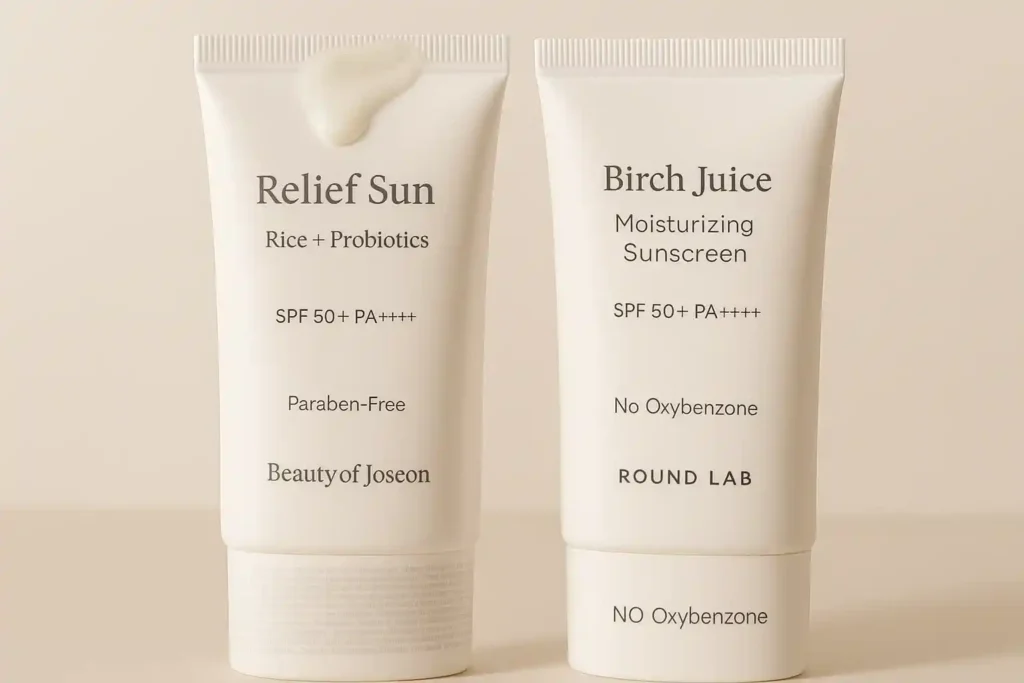
K-beauty has taken over the sunscreen world, and one of the biggest names leading this wave is Beauty of Joseon.
Their Relief Sun: Rice + Probiotics and the popular birch juice sunscreen (also seen in brands like the round lab birch juice sunscreen) are often praised for their lightweight texture and skin-friendly formulas.
But are they truly safe, or could they still hide bad ingredients in sunscreen? Let’s break it down.
When you look at beauty of joseon sunscreen ingredients, the first thing you notice is the absence of controversial filters like oxybenzone and octinoxate.
This is already a big plus because many people try to avoid these due to health and environmental concerns. Instead, the formula relies on modern, stabilized UV filters that offer broad-spectrum protection without breaking down quickly in sunlight.
What makes these sunscreens stand out is their thoughtful addition of skin-loving extras. Rice extract helps to brighten and soften, while probiotics support the skin barrier.
If you have sensitive skin, these gentle additions can make the formula more comfortable to wear every day compared to some heavy-duty options.
It’s also worth noting that unlike older formulas found in certain products, these sunscreens don’t typically include parabens or retinyl palmitate, two ingredients often flagged as unsafe in daily sun care.
Still, just because a product looks clean doesn’t mean you should stop reading labels altogether.
Always cross-check with guides like the INCI cheat sheet we shared earlier, especially if you’re comparing across brands such as bioderma sunscreen cream or bioderma sunscreen lotion.
In short, Beauty of Joseon and its Korean counterparts are setting a good example by avoiding many of the problematic ingredients and focusing on safe, photostable filters. That’s why these products are quickly becoming global favorites.
Bioderma Sunscreens: Safe Science or Hidden Risks?
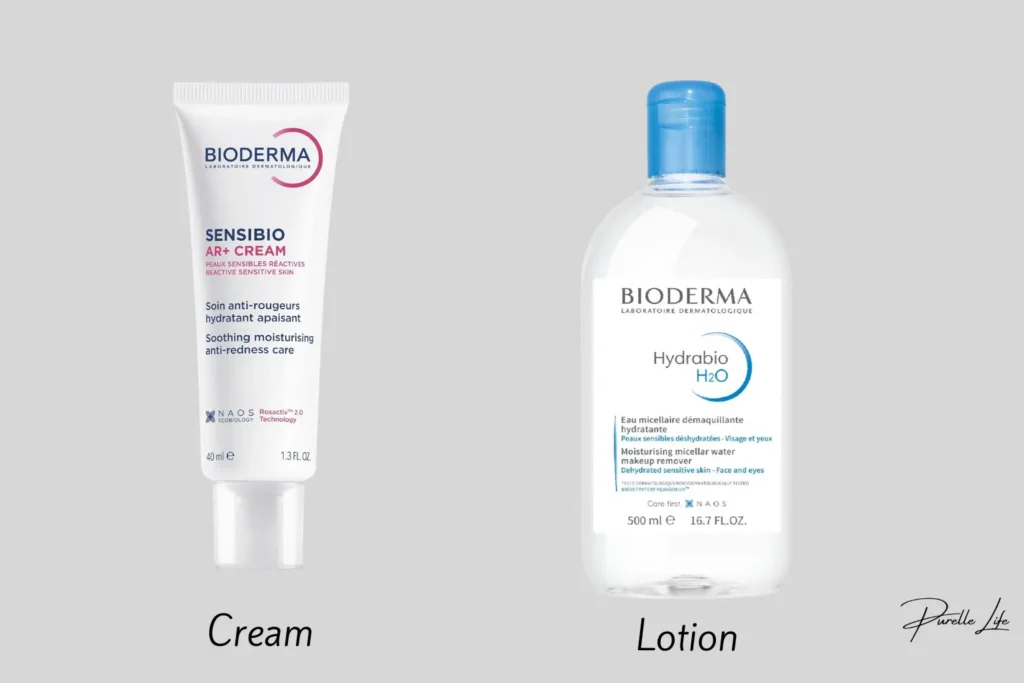
Bioderma is a trusted French skincare brand known for dermatologist-backed formulations.
But when it comes to sunscreen, many people wonder if their products are free from bad ingredients in sunscreen.
Let’s take a closer look at two of their popular options: bioderma sunscreen cream and bioderma sunscreen lotion.
The cream version is often recommended for dry or sensitive skin. Its formula is usually enriched with hydrating agents and designed to sit comfortably without leaving a heavy residue.
A big plus here is that Bioderma avoids common problem ingredients like oxybenzone and parabens in most of their latest creams. Instead, they focus on stabilized filters that provide reliable UVA and UVB protection.
This is important because unstable filters, like avobenzone when left unsupported, can lose their effectiveness under the sun.
Bioderma’s commitment to photostability makes its creams a safer choice compared to many generic sunscreens.
On the other hand, the lotion version is lighter and often suited for combination or oily skin. Similar to the cream, it avoids many controversial chemicals. However, as with any sunscreen, it’s still worth reading the label carefully.
Some formulas may include fragrance or alcohol, which can be irritating for extra-sensitive users.
Compared to some Korean favorites, like beauty of joseon sunscreen ingredients or even the newer birch juice sunscreen,
Bioderma leans more toward a clinical, dermatology-focused approach rather than adding plant extracts or trendy skin-boosting extras. Both philosophies have their strengths, but the key is choosing based on your skin type and sensitivity level.
In short, Bioderma sunscreens generally avoid the worst offenders and stand out for their photostable formulas. That said, always read the ingredient list and cross-check with known red flags before making a final choice.
Safe Sunscreen Choices That Truly Protect
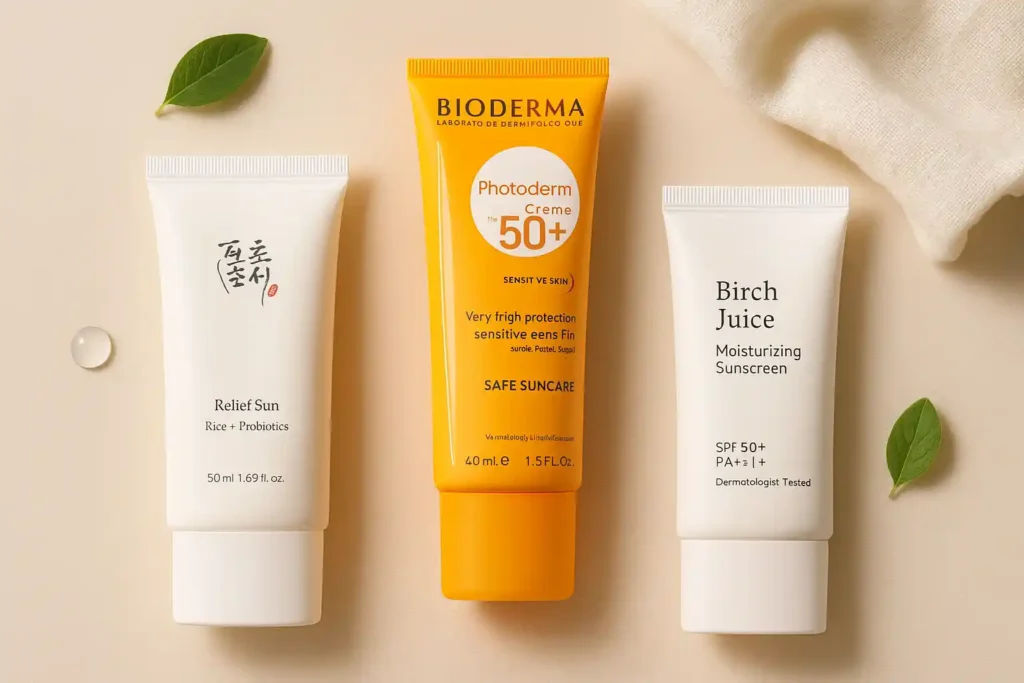
When shopping for sunscreens, it’s not just about SPF numbers. The real difference lies in the ingredients.
Many products still carry bad ingredients in sunscreen that may cause irritation, dryness, or even long-term skin concerns. That’s why knowing what to avoid and what to embrace is so important.
One safe route is to check labels for gentle and skin-friendly formulations. For example, the beauty of joseon sunscreen ingredients are often praised for being lightweight yet protective, especially for sensitive skin types.
They combine UV protection with nourishing elements that calm the skin instead of overwhelming it.
Hydration is another factor you shouldn’t overlook. A good pick here is birch juice sunscreen, which not only guards against harmful rays but also keeps the skin plump and refreshed throughout the day. It’s a perfect balance between sun care and skincare.
For those who prefer dermatologist-trusted options, bioderma sunscreen cream and bioderma sunscreen lotion are worth considering. Both are formulated with attention to safety and photostability, ensuring your skin stays protected without unnecessary risks.
Pregnancy & Sensitive Skin Guide: Sun Protection Made Safe
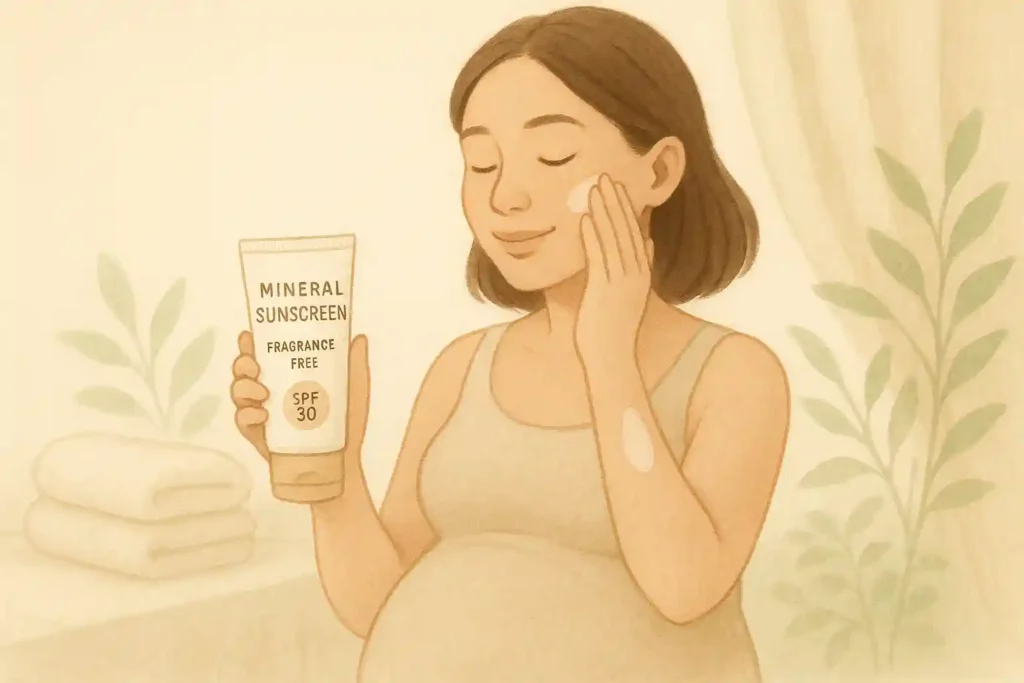
One of the biggest concerns during pregnancy is whether sunscreen is safe to use.
The truth is, sunscreen is not only safe but also important because pregnancy can make your skin extra sensitive to the sun, increasing the chances of dark spots and irritation.
What you need to be careful about are the bad ingredients in sunscreen that may not be ideal for moms-to-be or people with delicate skin.
Mineral-based options are often recommended because they sit on top of the skin and reflect UV rays instead of absorbing them.
They’re usually fragrance-free and less likely to trigger reactions. For example, beauty of joseon sunscreen ingredients are known for being gentle while still offering solid protection, which makes them a good pick for sensitive users.
Hydrating formulas can also help when skin feels dry or itchy. Something like birch juice sunscreen not only shields against UV rays but also soothes and nourishes at the same time.
Dermatologist-approved products such as bioderma sunscreen cream or bioderma sunscreen lotion are trusted worldwide because they avoid harsh additives while delivering reliable results.
If you’re pregnant or have sensitive skin, look for words like “mineral-based,” “fragrance-free,” and “clinically tested.” This way, you stay protected without worrying about hidden risks.
You may also love to read these articles:
Skin Care Complete Guide 2025: From Kids to Anti-Aging, Tips, Toners, and Peptides for Healthy Skin
Skinimalism 2.0: Build a Minimalist Routine That Actually Works (2025)
Retinol: 2025 Guide – How to Use, and What to Know Before & After
Most Common FAQs
What ingredients in sunscreen should be avoided?
You should watch out for bad ingredients in sunscreen like oxybenzone, octinoxate, and parabens. These are often linked to skin irritation or environmental concerns. Always check the label before buying.
Is Beauty of Joseon sunscreen safe?
Yes. Beauty of Joseon sunscreen ingredients are designed to be gentle, hydrating, and effective. They’re generally considered safe for sensitive skin and daily use.
Does Bioderma sunscreen contain harmful ingredients?
Both bioderma sunscreen cream and bioderma sunscreen lotion are dermatologist-tested and free from common irritants. They’re well-trusted in skincare routines, making them a safe pick for most users.
Which sunscreen ingredients are banned?
Certain chemical filters like oxybenzone and octinoxate have been banned in places such as Hawaii because of their effect on coral reefs. Always look for eco-friendly labels if you care about marine safety.
Is sunscreen safe during pregnancy?
Yes, but it’s best to stick with mineral-based sunscreens. Options that use zinc oxide or titanium dioxide, like birch juice sunscreen, are considered safe and gentle for pregnant women.
What is the safest sunscreen ingredient?
Dermatologists widely recommend zinc oxide and titanium dioxide as the safest sunscreen ingredients. They provide strong UV protection without being absorbed deeply into the skin.
Choosing the right sunscreen goes beyond SPF numbers, it’s about safety. Always avoid bad ingredients in sunscreen such as oxybenzone, parabens, and octinoxate. These can irritate skin and even harm the environment.
Safer options do exist. For example, beauty of joseon sunscreen ingredients focus on gentle, hydrating protection, while bioderma sunscreen cream and bioderma sunscreen lotion are trusted dermatologist-approved picks. Hydrating options like birch juice sunscreen also provide extra nourishment, making them great for sensitive or dry skin.
The takeaway is simple: choose sunscreens that are safe, photostable, and reef-friendly. Match them with your skin type, and you’ll enjoy reliable protection without hidden risks.
